3.key
- 格式:ppt
- 大小:350.50 KB
- 文档页数:5

Class :___________ 预备篇Welcome to school Name :____________1.Key words (汉译英) 1.我2.我的3.名字4.你的5.什么6.我是7.有,拥有8.天,一天9.美好的 10.女士 11.好的 12.早上13.书 14.打开 15.你好 4.Key sentences (英译汉) 1.Hello.My name is Amy ! 2.Hi!I’m Lingling. 3.What’s your name ? 4.Goodbye,Bobo, 5.Have a nice day! 6.Good morning! I’m Ms Smart . 7.Good morning, Ms Smart . 8.Welcome to school ! 2.Meet our new friends (看图连线) 1.Amy 2.Lingling 3.Sam 4.Daming 5.Bobo 4.Point and match (看图连线)1.Open your book!2.Stand up!3.Close your book!4.Sit down ! 1.Say! 2.Write ! 3.Point! 4.Listen !5.Read !=1.Key words (重点单词 -英汉互译) 1.你好2.美好的3.遇见4.你5.朋友6.成为7.开心,快乐8.天,一天9.他 10.她 11.来自 12.英国 13.好的,太棒了 14.twin 15.九16.share 17.listen 18.help 2.Key sentences (重点句子-英译汉) 1.Welcome ! 2.Hi,eveyone !I’m Sam. I’m nine. 3.She’s Amy. She’s nine, too. 4.We’re from the UK. We’re twins! 5.Hi,Sam. Hi, Amy. I’m Lingling. 6.He’s Daming. Come and play.7.We are friends! 8.Here you are. -Thank you. 8.Let’s help. 9.Let’s play together! -Great! 10.Hi,I’m Mia. He’s David. 11.A good friend plays with you. 12.Are you a good friend? 13.Yes .I help my friends . 3.Grammar (语法)1.I’m=2.She’s=3.He’s =4.We’re=5.Let’s= 4.Practices (练习) Task 1: 根据给出的图片及提示写句子。
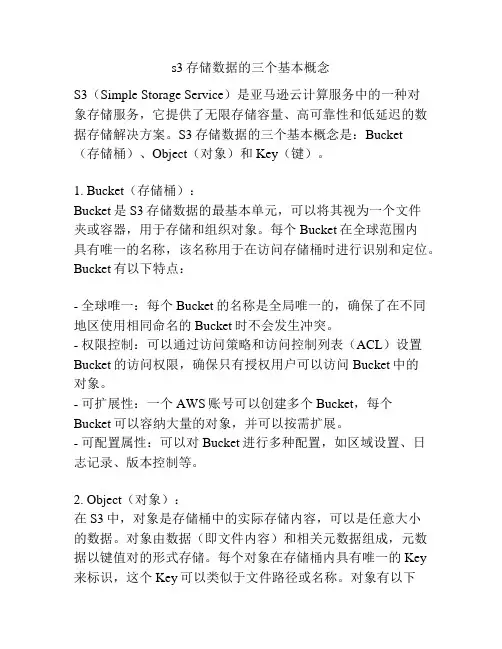
s3存储数据的三个基本概念S3(Simple Storage Service)是亚马逊云计算服务中的一种对象存储服务,它提供了无限存储容量、高可靠性和低延迟的数据存储解决方案。
S3存储数据的三个基本概念是:Bucket(存储桶)、Object(对象)和Key(键)。
1. Bucket(存储桶):Bucket是S3存储数据的最基本单元,可以将其视为一个文件夹或容器,用于存储和组织对象。
每个Bucket在全球范围内具有唯一的名称,该名称用于在访问存储桶时进行识别和定位。
Bucket有以下特点:- 全球唯一:每个Bucket的名称是全局唯一的,确保了在不同地区使用相同命名的Bucket时不会发生冲突。
- 权限控制:可以通过访问策略和访问控制列表(ACL)设置Bucket的访问权限,确保只有授权用户可以访问Bucket中的对象。
- 可扩展性:一个AWS账号可以创建多个Bucket,每个Bucket可以容纳大量的对象,并可以按需扩展。
- 可配置属性:可以对Bucket进行多种配置,如区域设置、日志记录、版本控制等。
2. Object(对象):在S3中,对象是存储桶中的实际存储内容,可以是任意大小的数据。
对象由数据(即文件内容)和相关元数据组成,元数据以键值对的形式存储。
每个对象在存储桶内具有唯一的Key 来标识,这个Key可以类似于文件路径或名称。
对象有以下特点:- 数据存储:对象可以存储任意类型的数据,包括文本文件、图片、音频、视频等等。
- 自定义元数据:可以在对象中添加自定义的元数据,比如版本号、文件名、文件类型、创建时间等等。
这些元数据可以在访问和操作对象时使用。
- 高可靠性:S3使用多个数据副本和数据分布来确保对象的高可靠性,即使一份副本出现问题,也可以通过其他副本恢复数据。
- 数据加密:可以对对象进行加密,保护数据的安全性。
3. Key(键):Key是对象在存储桶内的唯一标识符,类似于文件系统中的文件路径或名称。
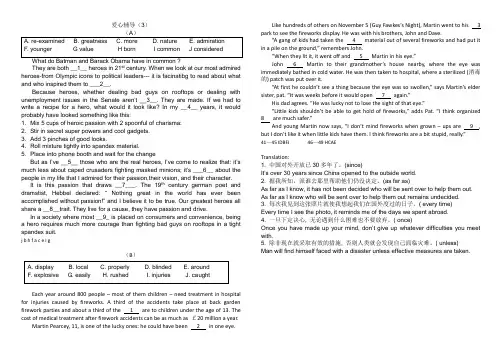
爱心辅导(3)They are both __1__ heroes in 21st century. When we look at our most admired heroes-from Olympic icons to political leaders--- it is facinatibg to read about what and who inspired them to ___2__.Because heroes, whether dealing bad guys on rooftops or dealing with unemployment issues in the Senate aren’t __3__. They are made. If we had to write a recipe for a hero, what would it look like? In my __4__ years, it would probably have looked something like this:1. Mix 5 cups of heroic passion with 2 spoonful of charisma:2. Stir in secret super powers and cool gadgets.3. Add 3 pinches of good looks.4. Roll mixture tightly into spandex material.5. Place into phone booth and wait for the changeBut as I’ve __5__ those who are the real heroes, I’ve come to realize that: it’s much less about caped crusaders fighting masked minio ns; it's ___6__ about the people in my life that I admired for their passion,their vision, and their character.It is this passion that draws __7___. The 19th century german poet and dramstist, Hebbel declared: “ Nothing great in the world has ever been ac complished without passion!” and I believe it to be true. Our greatest heroes all share a __8__trait. They live for a cause, they have passion and drive.In a society where most __9_ is placed on consumers and convenience, being a hero requires much more courage than fighting bad guys on rooftops in a tight spandex suit.j b h f a c e I g(B)Each year around 800 people –most of them children –need treatment in hospital for injuries caused by fireworks. A third of the accidents take place at back garden firework parties and about a third of the 1 are to children under the age of 13. The cost of medical treatment after firework accidents can be as much as £20 million a year.Martin Pearcey, 11, is one of the lucky ones: he could have been 2 in one eye.Like hundreds of others on November 5 (Guy Fawkes’s Night), Martin went to his 3 park to see the fireworks display. He was with his brothers, John and Dave.“A gang of kids had taken the 4 material out of several fireworks and had put it in a pile on the ground,” remembers John.“When they lit it, it went off and 5 Martin in his eye.”John 6 Martin to their grandmother’s house nearby, where the eye was immediately bathed in cold water. He was then taken to hospital, where a sterilized (消毒的) patch was put over it.“At first he couldn’t see a thing because the eye was so swollen,” says Martin’s elder sister, pat. “It was weeks before it would open 7 again.”His dad agrees. “He was lucky not to lose the sight of that eye.”“Little kids shouldn’t be able to get hold of fireworks,”adds Pat. “I think organized 8 are much safer.”And young Martin now says, “I don’t mind fireworks when grown –ups are 9 , but I don’t like it when little kids have them. I think fireworks are a bit stupid, really.”41—45 IDBFJ 46—49 HCAETranslation:1. 中国对外开放已30多年了。


•朗斯基行列式•刘维尔公式
(),(),,(0I t t ϕϕϕ≡L 设定义在区间上的函数)++()0n n c t t I I ϕ≡∈L , (*)在区间上线性相关;否则,线性无关。
一个方程,n 个未知量,怎么办?
t I
∈n 个方程,n 个未知量,克拉默法则!
构造些方程出来
以克拉默法则
需要系数矩
阵行列式
判断函数组线性相关性
1
=e
t
λλϕ
线性相关必要条件线性无关充分条件两个命题
()W t ⇒逆命题成立吗?即:若朗斯基行列式恒等于零能否推出线性相关?
00()0t W t ⇒∃≠逆命题成立吗?即:线性无关,朗斯基行列式?
线性无关的充分条件:朗斯基行列式在一点处不等于零
小结1
1
))n n dt dt dt
-
1012()00(),(),,()()=().
t
t n a s ds
t t t n I W t W t e
t I ϕϕϕ-
⎰L 刘维尔公式:若是阶线性齐次方程在区间上的n 个解,则它们的朗斯基行列式满足
.
其中是区间上任意一点0000()()()()W t I t I W t W t I t I W t ⇔∈≠⇔∈=在区间上恒不等于零存在,使得0.在区间上恒等于零存在,使得0.
线性无关充要条件线性相关充要条件
命
题3的证明
)
ϕ
0012
()
()(),(),,()
n
W t I
t I W t t t t I
ϕϕϕ
⇐⇔
∈≠⇒L
()由刘维尔公式,在区间上恒不等于零
存在,使得0在上线性无关.
解的
叠加
原理。
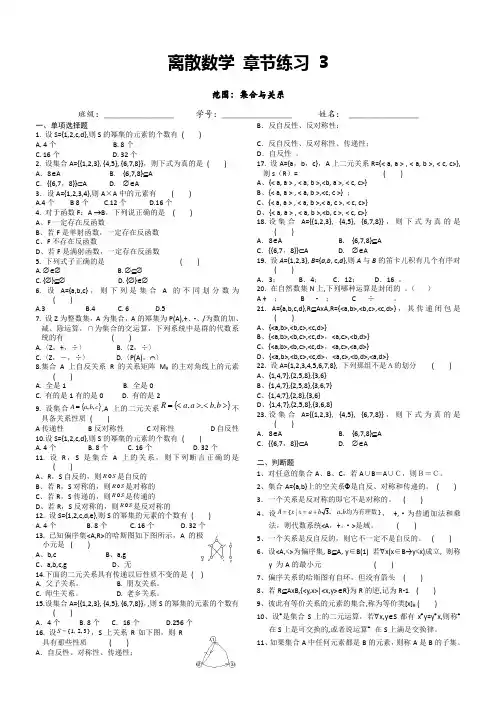
离散数学 章节练习 3范围:集合与关系班级:________________ 学号:________________ 姓名: ________________一、单项选择题 1. 设S={1,2,c,d},则S 的幂集的元素的个数有 ( )A. 4个B. 8个C. 16个D. 32个2. 设集合A={{1,2,3}, {4,5}, {6,7,8}},则下式为真的是 ( )A .8∈A B. {6,7,8}⊆AC .{{6,7,8}}⊂A D. ∅∈A3.设A={1,2,3,4},则A ×A 中的元素有 ( )A.4个 B 8个 C.12个 D.16个4. 对于函数F :A →B ,下列说正确的是 ( )A 、F 一定存在反函数B 、若F 是单射函数,一定存在反函数C 、F 不存在反函数D 、若F 是满射函数,一定存在反函数5. 下列式子正确的是 ( )A. ∅∈∅B. ∅⊆∅C. {∅}⊆∅D. {∅}∈∅6. 设A={a,b,c},则下列是集合A 的不同划分数为( )A.3B.4C. 6D.57. 设Z 为整数集,A 为集合,A 的幂集为P(A),+、-、/为数的加、减、除运算,∩为集合的交运算,下列系统中是群的代数系统的有 ( )A.〈Z ,+,÷〉B.〈Z ,÷〉C.〈Z ,-,÷〉D.〈P(A),⋂〉8.集合A 上自反关系R 的关系矩阵M R 的主对角线上的元素( )A. 全是1B. 全是0C. 有的是1有的是0D. 有的是29. 设集合{}c b a A ,,=,A 上的二元关系{}><><=b b a a R ,,,不具备关系性质 ( )A 传递性B 反对称性C 对称性D 自反性10.设S={1,2,c,d},则S 的幂集的元素的个数有 ( )A. 4个B. 8个C. 16个D. 32个11. 设R ,S 是集合A 上的关系,则下列断言正确的是( )A 、R ,S 自反的,则S R 是自反的B 、若R ,S 对称的,则S R 是对称的C 、若R ,S 传递的,则S R 是传递的D 、若R ,S 反对称的,则S R 是反对称的12. 设S={1,2,c,d,e},则S 的幂集的元素的个数有 ( )A. 4个B. 8个C. 16个D. 32个 13. 已知偏序集<A,R>的哈斯图如下图所示,A 的极小元是 ( )A 、b,cB 、a,gC 、a,b,c,gD 、无 14.下面的二元关系具有传递以后性质不变的是 ( ) A. 父子关系。

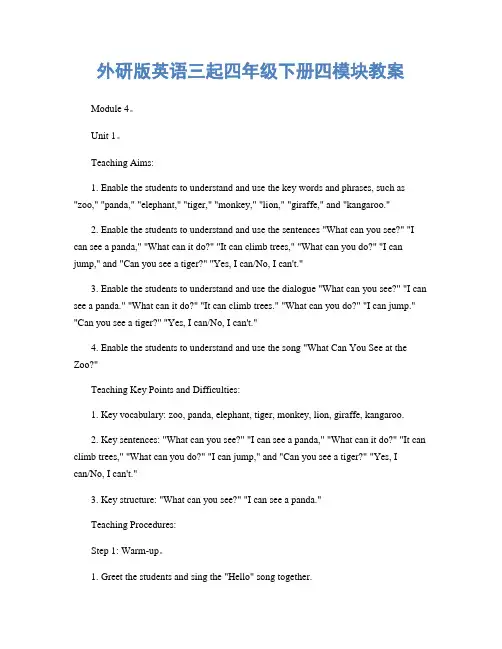
外研版英语三起四年级下册四模块教案Module 4。
Unit 1。
Teaching Aims:1. Enable the students to understand and use the key words and phrases, such as "zoo," "panda," "elephant," "tiger," "monkey," "lion," "giraffe," and "kangaroo."2. Enable the students to understand and use the sentences "What can you see?" "I can see a panda," "What can it do?" "It can climb trees," "What can you do?" "I can jump," and "Can you see a tiger?" "Yes, I can/No, I can't."3. Enable the students to understand and use the dialogue "What can you see?" "I can see a panda." "What can it do?" "It can climb trees." "What can you do?" "I can jump." "Can you see a tiger?" "Yes, I can/No, I can't."4. Enable the students to understand and use the song "What Can You See at the Zoo?"Teaching Key Points and Difficulties:1. Key vocabulary: zoo, panda, elephant, tiger, monkey, lion, giraffe, kangaroo.2. Key sentences: "What can you see?" "I can see a panda," "What can it do?" "It can climb trees," "What can you do?" "I can jump," and "Can you see a tiger?" "Yes, Ican/No, I can't."3. Key structure: "What can you see?" "I can see a panda."Teaching Procedures:Step 1: Warm-up。
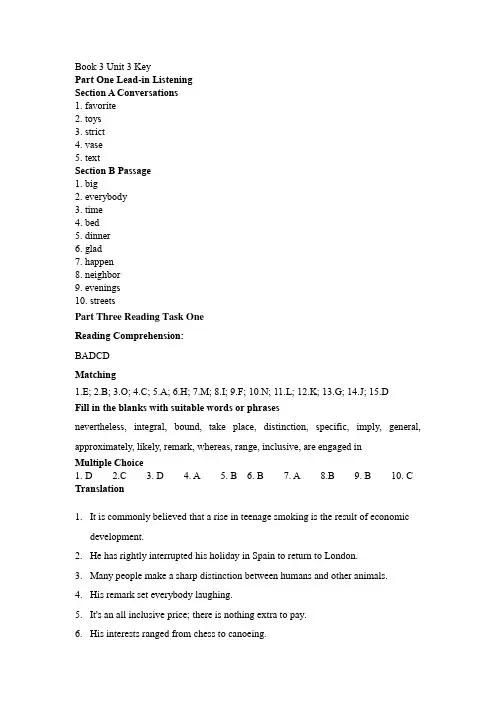
Book 3 Unit 3 KeyPart One Lead-in ListeningSection A Conversations1. favorite2. toys3. strict4. vase5. textSection B Passage1. big2. everybody3. time4. bed5. dinner6. glad7. happen8. neighbor9. evenings10. streetsPart Three Reading Task OneReading Comprehension:BADCDMatching1.E;2.B;3.O;4.C;5.A;6.H;7.M;8.I;9.F; 10.N; 11.L; 12.K; 13.G; 14.J; 15.DFill in the blanks with suitable words or phrasesnevertheless, integral, bound, take place, distinction, specific, imply, general, approximately, likely, remark, whereas, range, inclusive, are engaged inMultiple Choice1.D2.C3. D4. A5. B6. B7. A8.B9. B10. C Translation1.It is commonly believed that a rise in teenage smoking is the result of economicdevelopment.2.He has rightly interrupted his holiday in Spain to return to London.3.Many people make a sharp distinction between humans and other animals.4.His remark set everybody laughing.5.It's an all inclusive price; there is nothing extra to pay.6.His interests ranged from chess to canoeing.7.The arms and legs are integral parts of a human body.8.The flavor of dishes may vary from place to place.9.The plane will be taking off in approximately five minutes.10.The trouble with Bill was that he never had a specific aim in life.Part Four Reading Task TwoAnswers to questions1.The digital age has had a good influence and a not-so-good influence on this generation of American teenagers.2.Three quarters of the teachers3.Many students think doing research now means just doing a quick search on Google, so they embrace these tools.4.Ms. Buchanan says digital research tools are helping students learn more, and learn faster.5.Many students are lacking in digital literacy and are able to quickly find information online.。
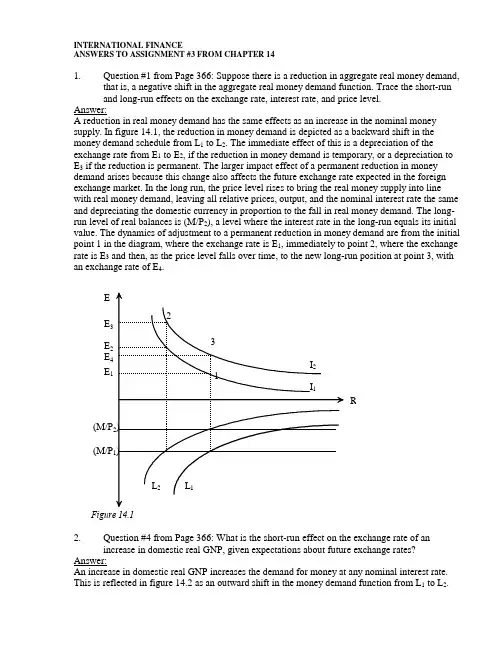
INTERNATIONAL FINANCEANSWERS TO ASSIGNMENT #3 FROM CHAPTER 141. Question #1 from Page 366: Suppose there is a reduction in aggregate real money demand,that is, a negative shift in the aggregate real money demand function. Trace the short-run and long-run effects on the exchange rate, interest rate, and price level. Answer:A reduction in real money demand has the same effects as an increase in the nominal money supply. In figure 14.1, the reduction in money demand is depicted as a backward shift in the money demand schedule from L 1 to L 2. The immediate effect of this is a depreciation of the exchange rate from E 1 to E 2, if the reduction in money demand is temporary, or a depreciation to E 3 if the reduction is permanent. The larger impact effect of a permanent reduction in money demand arises because this change also affects the future exchange rate expected in the foreign exchange market. In the long run, the price level rises to bring the real money supply into linewith real money demand, leaving all relative prices, output, and the nominal interest rate the same and depreciating the domestic currency in proportion to the fall in real money demand. The long-run level of real balances is (M/P 2), a level where the interest rate in the long-run equals its initial value. The dynamics of adjustment to a permanent reduction in money demand are from the initial point 1 in the diagram, where the exchange rate is E 1, immediately to point 2, where the exchange rate is E 3 and then, as the price level falls over time, to the new long-run position at point 3, with an exchange rate of E 4.R(M/P E 1E 4E 2E 3E(M/PFigure 14.12. Question #4 from Page 366: What is the short-run effect on the exchange rate of anincrease in domestic real GNP, given expectations about future exchange rates?Answer:An increase in domestic real GNP increases the demand for money at any nominal interest rate. This is reflected in figure 14.2 as an outward shift in the money demand function from L 1 to L 2.The effect of this is to raise domestic interest rates from R 1 to R 2 and to cause an appreciation of the domestic currency from E 1 to E 2.REE 1E 2RE(M 1E 3E 2E 1(M 2E 43. Question #10 from Page 367: In the discussion of short-run exchange rate overshooting,we assumed that real output was given (fixed). Assume instead that an increase in themoney supply raises real output in the short run. How does this affect the extent to which the exchange rate overshoots when the money supply first increases? Is it likely that the exchange rate undershoots? (Hint: in Figure 14-12a of the book – the money demand –money supply diagram, allow the aggregate real money demand schedule to shift inresponse to the increase in output.)Answer:If an increase in the money supply raises real output in the short run, then the fall in the interest rate will be reduced by an outward shift of the money demand curve caused by the temporarily higher transactions demand for money. In figure 14.3, the increase in the money supply line from (M1/P) to (M2/P) is coupled with a shift out in the money demand schedule from L1 to L2. The interest rate falls from its initial value of R1 to R2, rather than to the lower level R3, because of the increase in output and the resulting outward shift in the money demand schedule. Because the interest rate does not fall as much when output rises, the exchange rate depreciates by less: from its initial value of E1 to E2, rather than to E3, in the diagram. In both cases we see the exchange rate appreciate back some to E4 in the long run. The difference is the overshoot is much smaller if there is a temporary increase in Y. Note, the fact that the increase in Y is temporary means that we still move to the same IP curve, as LR prices will still shift the same amount when Y returns to normal and we still have the same size M increase in both cases. A permanent increase in Y would involve a smaller expected price increase and a smaller shift in the IP curve. Undershooting occurs if the new short-run exchange rate is initially below its new long-run level. This happens only if the interest rate rises when the money supply rises—that is if GDP goes up so much that R does not fall, but increases. This is unlikely because the reason we tend to think that an increase in M may boost output is because of the effect of lowering interest rates, so we generally don’t think that the Y response can be so great as to increase R.4.We learned that an increase in domestic money supply causes exchange rate to overshoot inthe short run and then in the long run with domestic price adjustment the exchange rate reverts to a lower level (but at a level higher than the initial level prevailing before the increase in money supply.) Use this knowledge of short-run and long-run effects of a change in domestic money supply to examine both the short-run and long-run effects of an increase foreign money supply on exchange rate.Answer:Effects are going to be exactly opposite to the effects of an increase in domestic money supply ($). An increase in foreign money supply (euro) causes exchange rate ($ per euro) to undershoot in the short run and then in the long run with foreign price adjustment the exchange rate reverts to a higher level (but at a level lower than the initial level prevailing before the increase in foreign money supply.。
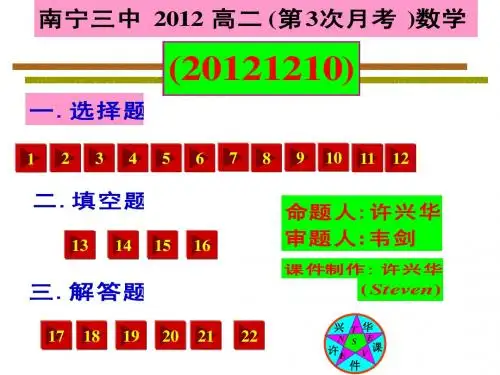
Chapter 2Section One True or false1.Economic forces only influence the GDP of a country, which has little influenceon the strategy making of one small company. (F)2.Disposable income is the money consumers have after purchasing their necessities.(F)3.The consumer can also play a direct and active role in influencing what happens inthe marketplace. (T)4.If the price of coffee rises too much, the tea market will shrink as well as thecoffee market. (F)5.The microenvironment consists of the forces close to the company that affect itsability to serve its customers, including the company, suppliers, marketing channel firms, customer markets, competitors and publics. (T)6.Marketing services agencies help the company to stock and move goods fromtheir points of origin to their destinations. (F)7.Many consumers in recession want the "best" of everything and are willing to payfor it, because it is cheap. (F)Section Two Multiple choice1.Why must businesses continually monitor changes in the technical environment?A)To see if competitors are copying their ideas.B)To replace aging equipment.C)To identify cheaper suppliers.D)To identify emerging opportunities and threats. (D)2.Which of the following are belonging to the social forces?A)The value consciousness.B)Government stability.C)Legislation.D)Spending and savings. (A)3.What is the least possible effect of “one child policy” in China?A)Toy market becomes prosperous.B)Gray market becomes prosperous.C)Education market becomes prosperous.D)Health care market becomes prosperous. (B)4.“People make up the market”, what does this statement mean?A)Sales people can change the market environment.B)Analyzing the characteristics of people is important for marketers.C)Market place is always full of people.D)None of the above. (B)Chapter 3Section One True or false1.Price is the only factor in the marketing mix that generates revenue, so price is themost important factor in the marketing mix. (F)2.At the introduction stage, price may be set high to capitalize on the product’suniqueness. (T)3.High prices can be enjoyed in the short term where demand is relatively elastic.(F)4.Promotional discount is a short-term discounted price. (T)5.Charging different customers different price is known as price discrimination. (T)Section Two Multiple Choice1.The P’s in McCarthy’s 4Ps stand for:A)price, promotion, place and positioning.B)promotion, personal selling, price and positioning.C)price, promotion, place and product.D)people, processes, physical evidence and product. (C)2.Which of the following is an example of an own-label brand?A)P&G.B)Wal-Mart.C)IBMD)Rolex watch. (B)3.In marketing theory, the acronym “PLC” stands for ( )A)price list costing.B)product life cycle.C)promotional life cycle.D)product line classification. (B)4.In terms of its final use the product can be defined as ( )A)consumer goods and industrial goods.B)durable goods and non-durable goods.C)services and goods.D)none of the above. (A)5. A successful penetration pricing may lead to ( )A)image of quality.B)large salesC)maximizing profitD)all of the above. (B)6.Trade discount is offered to ( )A)end users.B)channel members.C)encourage early payment.D)reduce seasonal variation in sales. (B)7.When promotional pricing is used, the manufacturer wants to ( )A)pass the idea on to the end consumer that the price cut as a special exceptionaloffer and minimize the perception that the product may be of lower quality because it is offered at a lower price.B)direct the price cut to first-time buyers.C)minimize the extent to which repeat buyers can take advantage of it to makemultiple purchases.D)both benefit the end customer and add to the margin of a distributor. (A)。
英语读写(3) 第三单元第3单元练习I. RF3-RF-03Key: 1-5 T F N T F 6-10 F N T T TDirections: In this part, you will have 15 minutes to go over a passage quickly and read ten statements in it.For statements 1-10, writeT(for True)if the statement agrees with the information given in the above paragraph(s);F (for False) if the statement contradicts the information given in the above paragraph(s);N (for Not given) if the statement is not given in the above paragraph(s);Best of friends, Worlds ApartHavana, sometime before 1994: As dusk descends on the quaint seaside village of Guanabo, two young men kick a soccer ball back and forth and back and forth across the sand. The tall one, Joel Ruiz, is black. The short, muscular one, Achmed Valdes, is white.They are the best of friends.Miami, January 2000: Mr. Valdes is playing soccer, as he does every Saturday, with a group of light-skinned Lationos in a park near his apartment. Mr. Ruiz surprises him with a visit, and Mr. Valdes, flushed and sweating, runs to greet him. They shake hands warmly.But when Mr. Valdes darts back to the game, Mr. Ruiz stands off to the side, arms crossed, looking on as his childhood friend plays the game that was once their shared joy. Mr. Ruiz no longer plays soccer. He prefers basketball with black Latinos and African-Americans from his neighborhood.The two men live only four miles apart, not even 15 minutes by car. Yet they are separated by a far greater distance, one they say they never imagined back in Cuba.In ways that are obvious to the black man but far less so to the white one, they have grown apart in the United States because of race. For the first time, they inhabit a place where the color of their skin defines the outlines of their lives -where they live, the friends they make, how they speak, what they wear, even what they eat. “It’s like I am here and he is over there,” Mr. Ruiz said, “And we can’t cross over to the other’s world.”It is not that, growing up in Cuba’s mix of black and white, they were unaware of their difference in color. Fidel Castro may have officially put an end to racism in Cuba, but that does not mean racism has simply gone away. Still, color was not what defined them. Nationality, they had been taught, meant far more than race. They felt, above all, Cuban.Here in America, Mr. Ruiz still feels Cuban. But above all he feels black. His world is a black world, and to live there is to be constantly conscious of race. He works in a black-owned bar, dates black women, goes to an African-American barber. “White ba rbers”, he say, “don’t understand black hair.” He generally avoids whiteneighborhoods, and when his world and the white world meet, he feels always watched, and he is always watchful.For Joel Ruiz, there is little time for relaxation. On this night, he works as a cashier at his uncle’s bar in a black Miami neighborhood.Mr. Valdes, who is 29, a year younger than his childhood friend, is simply, comfortably Cuban, an upwardly mobile citizen of the Miami mainstream. He lives in an all-white neighborhood, hangs out with white Cuban friends and goes to black neighborhoods only when his job, as a deliveryman for Restonic mattresses, forces him to. When he thinks about race, which is not very often, it is in terms learned from other white Cubans: American blacks, he now believes, are to be avoided because they are dangerous and resentful of whites. The only blacks he trusts, he says, are those he knows from Cuba.Since leaving Havana in separate boats in 1994, the two friends have seen each other just a handful of times in Miami -at a funeral, a baby shower, a birthday party and that soccer game, a meeting arranged for a newspaper photographer. They have visited each other’s homes only once.They say they remain as good friends as ever, yet they both know there is little that binds them anymore but their memories. Had they not become best friends in another country, in another time, they would not be friends at all today.Statements1. Mr. Ruiz and Mr. Valdes are both Cuban- Americans.2. Mr. Ruiz and Mr. Valdes feel separated from each other in the United States because they don’t live in the same neighborhood.3. In the United States, the color of one’s skin will influence the way they travel4. In Cuba, people feel that compared to nationality, the color of one’s skin isunimportant.5. Mr. Valdes thinks white barbers don’t understand black hair.6. Living in a white neighborhood, Mr. Valdes seems to be unconscious of racial issues.7. Mr. Ruiz lives in an apartment in a black neighborhood.8. It can be inferred from the passage that Mr. Valdes can still move up the socialladder.9. Both Mr. Ruiz and Mr. Valdes left Cuba in 1994.10. All that Mr. Ruiz and Mr. Valdes have left of their friendship are their memories. II. CVBDirections: Choose the best answer to complete each of the following sentences. (Key: A)1. She ______ her mind by reading many books.A) cultivated B) educated C) civilized D) tamed(Key: B)2. You must take the ______ steps by yourself; after you have begun, I will help you.A) primitive B) preliminary C) primary D) prime(Key: C)3. After three hours of heated debate, the ______ bill was passed by a narrow majority.A) virtual B) universal C) controversial D) substantial(Key: A)4. They must know how to make use of, and, when necessary, to discard the old______ rules.A) conventional B) conservative C) constant D) convenient(Key: C)5. I have tried to make the questions simple but ______ so that it won’t take many minutes to fill in; but your answers will give me a good idea of what is wanted and what is not.A) integrated B) comparative C) comprehensive D) comprehensible (Key: D)6. Two independent daily newspapers had been ordered to ______ publication on June.A) concentrate B) comprehend C) suspect D) suspend(Key: A)7. It is made quite clear in the document that China will stick to its ______ and opening up policy.A) reform B) transformation C) refrain D) formation(Key: C)8. He is a person of average ______ .A) talent B) prominence C) intelligence D) celebrity(Key: B)9. When the news media and the public show a lot of interest in something, you cansay that it is receiving ______ .A) popularity B) publicity C) publication D) priority(Key: D)10. I felt most ______ when the shop assistant refused to show me the skirt and said that I didn’t seem to be able to afford it.A) scolded B) blamed C) cursed D) insulted(Key: A)11. Disappointment ______ on his face when he heard that he didn’t passed the entrance examination.A) registered B) enrolled C) recorded D) enteredIII. Word BuildingDirections: Fill in the blanks with the appropriate word forms of the words given in the brackets.1. Key: acceptance1. These scientists developed some new ideas and concepts, which gained ______rapidly. (accept)2. Key: energetic2. Iron deficiency may derive from frequent ______ exercises. (energy)3. Key: publicity3. Some people, especially stars, try to seek ______ while some others try to avoid it.(public)4. Key: Enrollments4. ______ in linguistics and history have fallen off. (enroll)5. Key: controversy5. The new plan led to a heated ______ . (controversial)6. Key: comprehension6. We are going to do a reading ______. (comprehensive)7. Key: Curiosity7. ______ caused the girl to open the door. (curious)8. Key: suspended8. Some rail services were ______ during the strike. (suspend)9. Key: preparation9. He didn’t do enough ______ for his exam, and failed. (prepare)10. Key: economy10. The new oil that we have found will improve our ______ . (economic)IV. ECTDirections: Translate the English sentences into Chinese.1. 答案:海德中学的办学宗旨是:如果你向学生传授诸如求真、勇敢、正直、领导能力、好奇心和关心他人等美德的话,学生的学习成绩自然就会提高。
SQLITE3 加密总结(sqlite 3.6.12版本)董淳光42530 (老工号)***************2009年4月9日星期四I. 序 (1)II. 问题初分析 (2)III. 研究结果(附代码) (3)IV. 可靠性 (17)V. 关键点说明 (17)I.序时隔上次写《Sqlite3 使用总结》已过去2年。
这2年时间我做了好些对自己人生影响很大的事情。
不扯太远了。
2年来一直想把sqlite3 的加密搞清楚一些,但一直没时间去做。
这两天终于有空坐下来研究sqlite3 的加密方法。
有点收获。
记录下来免得忘记。
我写本文章时,sqlite3 最新版本是 3.6.12 。
我就以这个版本的源代码为例进行分析。
并且,我喜欢它那整合代码,整合成一个.c 和一个.h 文件。
虽然在vc2003 里编辑慢如蜗牛,但是一旦编辑好,以后使用起来不至于每个工程都拖上一堆文件。
工程简洁方便。
所以下面的叙述全部都是以sqlite3 v3.6.12 整合的源代码为基础展开。
我认为未来sqlite3 v3.XX 的整合版本大体上都可以用下面介绍的代码进行加解密。
Sqlite3 在版本变化中,有一些宏、函数被改名,读者很容易查出来并自己修正。
也有一些函数会被丢弃。
读者应该也可以自行分析出来。
我下面的代码尽可能保持与sqlite 版本的兼容性。
不使用那些容易被丢弃的结构或函数。
这样以后就不会常常有人发邮件咨询我能否制作一个最新版本sqlite加密了。
II.问题初分析首先是要理清sqlite3 加解密思路。
这点在2年前就没有做到位。
我本人愚笨,不擅长凭空分析太抽象的事情。
对于软件问题最希望的就是边看现象边理解。
分析sqlite3 加密思路也采用具体现象具体分析的方法。
还是vc2003 编译器(使用其它编译器的读者可以自行对应着设置,我下面的叙述并没有使用过多的vc2003 编译技巧,对应到vc2005、2008,甚至unix 下的cc 等等都是通用的)。
Unit 3Keys for 1.3.12.1.1 Check the reviewing section of sample Introduction and complete the following table.2.2.2 Read three extracts on the issue of poverty and crime. Use the verbs above to cite opinions on poverty and crime.A study by Williams (2011) reports that percentage of poor Americans who are living in extreme poverty has reached a 32-year high, resulting in severe social problems. The findings are supported by Holmes (2011) who further states that there are more and more at the link between unemployment, poverty and crime. And the unmistakable charac teristic of poverty and crime is that they’re both geographically concentrated in the same areas. This opinion is theoretically explained from an economic perspective of crime that people weigh the consequences of committing crime. They resort to crime only if the cost or consequences are outweighed by the potential benefits to be gained (Garland, 2012).Although both these studies focus on the close relation between poverty and crime, they have ignored … according to Leach and Mearns (2012).3.1 Using referencesInformation prominent citationAmong the six areas regarding the poverty headcount ratio at $1.25 a day,Author prominent citationThe World Bank (2012) stated that South Asia ranked the second in the chart regarding poverty ratio at $1.25 a day among six areas in the world.Weak author prominent citationAs a report from the World Bank (2012) indicated, the top two areas of poverty headcount ratio at $1.25 a day were sub-Saharan Africa and South Asia, with a population of almost 50 percent and 37 percent respectively.3.2 Relating literature to your researchWhat questions does this literature review answer?(Key: This literature offers a summary of previous research, so it simply tells the reader what was discovered in previous research.)What questions doesn't it answer?(Key: It doesn't evaluate the research it summarizes, nor does it show the relationships between the different theories, views and approaches it describes.)Which method has the writer used to organize the literature review?(Key: The writer has organized this literature review around the researchers, and has presented it chronologically (arranging the work by when it was published). Notice that by organizing it around the researchers (the summaries are listed after the names of the people who did the research) and not around the research (e.g. around key concepts) the writer emphasizes the people and not their work.)Is it a good literature review? Why?(Key: We don't believe that it is a good literature review. It only gives a summary of previous research but it does not use the literature to explain more about the writer's own research problem. Also, it is not critical: after we read it we still do not know which theories or findings are important, which are inconclusive, what the shortcomings are, etc.The main problem with this literature review is that it does not show how previous research relates to the writer's own research problem, or the relationship between different researches already carried out. Given the organization the writer has used, this literature review could not be effective literature review because there is little scope for showing relationships, drawing comparisons, or making evaluations.)3.3 Avoiding plagiarismThe last sentence in Version 2 sounds like the idea of the writer of the paragraph, butwe know from Version 1 that it was originally the idea of Russell and Fillery (1996). Because there is no grammatical link between the two sentences, the reference in the first sentence does not apply to the second sentence. Note in Version 1 that the authors used both a grammatical link (they) and a tense marker (the past tense was not adaptable) to indicate that the idea came from the cited work.。
vue3 ts reactive key类型-回复Vue3的全新响应式系统是其最重要的改进之一。
在Vue2中,我们使用`data`选项来定义组件的响应式状态,但在Vue3中,我们可以使用新的`reactive`函数来实现这一目标。
其中一个与`reactive`函数相关的重要概念是键(key)的类型。
在Vue2中,键的类型被限制为字符串,这导致了一些问题。
然而,在Vue3中,我们可以使用更灵活的键类型来定义我们的响应式状态。
在本文中,我们将深入探讨Vue3中可用的键类型,并解释它们的用法。
什么是键类型?在Vue中,键类型是我们在响应式状态对象中使用的键的类型。
在Vue2中,键的类型被限制为字符串,这意味着我们只能使用字符串键来定义响应式状态。
例如:data() {return {name: 'John',age: 25,};}在上面的例子中,`name`和`age`都是字符串键,它们对应于`name`和`age`属性。
然而,这种限制过于简单,不够灵活。
在Vue3中,我们可以使用不同类型的键来定义响应式状态。
这些键类型包括:字符串键、Symbol键和数值键。
字符串键字符串键是最常见的键类型,它们与Vue2中的键类型是相同的。
我们可以使用字符串键来定义我们的响应式状态。
例如:typescriptimport { reactive } from 'vue';const state = reactive({name: 'John',age: 25,});在上面的示例中,我们使用字符串键`name`和`age`来定义我们的响应式状态。
字符串键的优点是非常简单,容易理解和使用。
它们与Vue2中的键类型完全兼容。
然而,字符串键也有一些缺点。
首先,它们不是类型安全的,我们可以轻易地犯错而不会得到编译器的提示。
例如,我们可以拼写错误或使用错误的键名,而不会得到任何警告。